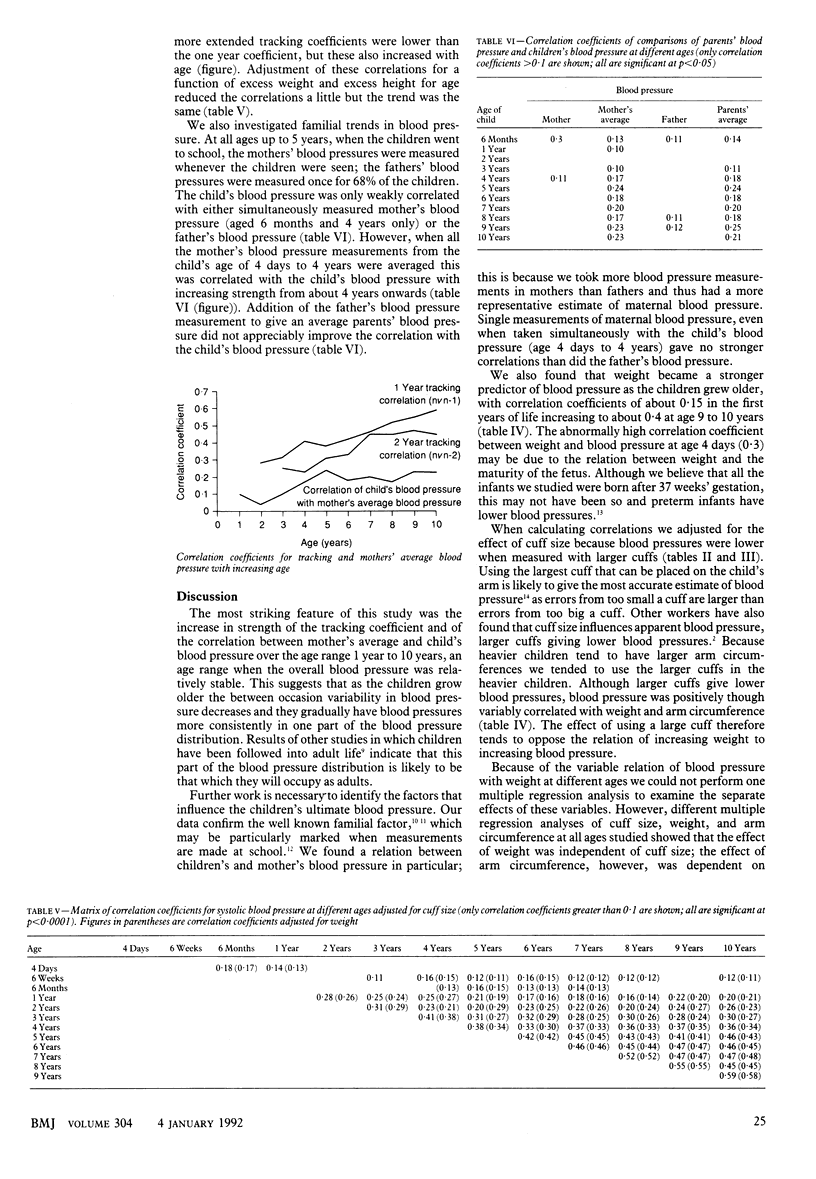Abstract
OBJECTIVES--To determine the normal range of blood pressure and its pattern of change in the first 10 years of life. To estimate at what age (if any) children consistently appear in one part of the blood pressure distribution and at what age familial correlations in blood pressure become significant. DESIGN--Longitudinal cohort study. SETTING--South east England. SUBJECTS--2088 children of both sexes born consecutively in Farnborough Hospital, Kent, and their parents. MAIN OUTCOME MEASURE--Blood pressure measured by Doppler ultrasonography and sphygmomanometry. RESULTS--Systolic blood pressure rose from a mean of 88.5 mm Hg at age 6 months to 96.2 mm Hg at 8 years measured with a 8 cm cuff and from 89.1 mm Hg at age 5 years to 94.3 mm Hg at age 10 years measured with a 12 cm cuff. The larger cuff gave blood pressure readings about 6 mm Hg lower. This effect was independent of body weight and arm circumference. Diastolic blood pressure rose from 57.8 mm Hg at 5 years to 61.8 mm Hg at 10 years (12 cm cuff). There was only about 1 mm Hg difference between sexes. Blood pressure was correlated with weight, weight adjusted for height, height, and arm circumference at all ages studied. The correlation coefficient of repeated yearly measurements increased steadily with age from 0.28 at 2 years to 0.59 at 10 years. The correlation coefficients between child's blood pressure and mother's average blood pressure increased from 0.1 at age 1 year to 0.23 at age 10. CONCLUSIONS--Blood pressure changes relatively little between the ages of 6 months and 10 years. Yet because of the increasing strength of between occasion and family correlations, children are more consistently occupying a specific part of the blood pressure distribution as they grow older. Studies in children should help determine why some adults have hypertension and others do not.
Full text
PDF



Selected References
These references are in PubMed. This may not be the complete list of references from this article.
- Burke G. L., Voors A. W., Shear C. L., Webber L. S., Smoak C. G., Cresanta J. L., Berenson G. S. Cardiovascular risk factors from birth to 7 years of age: the Bogalusa Heart Study. Blood pressure. Pediatrics. 1987 Nov;80(5 Pt 2):784–788. [PubMed] [Google Scholar]
- Clarke W. R., Schrott H. G., Burns T. L., Sing C. F., Lauer R. M. Aggregation of blood pressure in the families of children with labile high systolic blood pressure. The Muscatine Study. Am J Epidemiol. 1986 Jan;123(1):67–80. doi: 10.1093/oxfordjournals.aje.a114225. [DOI] [PubMed] [Google Scholar]
- Cole T. J. Weight/heightp compared to weight/height2 for assessing adiposity in childhood: influence of age and bone age on p during puberty. Ann Hum Biol. 1986 Sep-Oct;13(5):433–451. doi: 10.1080/03014468600008621. [DOI] [PubMed] [Google Scholar]
- De Swiet M., Fancourt R., Peto J. Systolic blood pressure variation during the first 6 days of life. Clin Sci Mol Med. 1975 Dec;49(6):557–561. doi: 10.1042/cs0490557. [DOI] [PubMed] [Google Scholar]
- Hofman A., Hazebroek A., Valkenburg H. A. A randomized trial of sodium intake and blood pressure in newborn infants. JAMA. 1983 Jul 15;250(3):370–373. [PubMed] [Google Scholar]
- Rosner B., Hennekens C. H., Kass E. H., Miall W. E. Age-specific correlation analysis of longitudinal blood pressure data. Am J Epidemiol. 1977 Oct;106(4):306–313. doi: 10.1093/oxfordjournals.aje.a112466. [DOI] [PubMed] [Google Scholar]
- Shear C. L., Burke G. L., Freedman D. S., Berenson G. S. Value of childhood blood pressure measurements and family history in predicting future blood pressure status: results from 8 years of follow-up in the Bogalusa Heart Study. Pediatrics. 1986 Jun;77(6):862–869. [PubMed] [Google Scholar]
- Versmold H. T., Kitterman J. A., Phibbs R. H., Gregory G. A., Tooley W. H. Aortic blood pressure during the first 12 hours of life in infants with birth weight 610 to 4,220 grams. Pediatrics. 1981 May;67(5):607–613. [PubMed] [Google Scholar]
- Whincup P. H., Cook D. G., Shaper A. G. Early influences on blood pressure: a study of children aged 5-7 years. BMJ. 1989 Sep 2;299(6699):587–591. doi: 10.1136/bmj.299.6699.587. [DOI] [PMC free article] [PubMed] [Google Scholar]
- Wilson P. D., Ferencz C., Dischinger P. C., Brenner J. I., Zeger S. L. Twenty-four-hour ambulatory blood pressure in normotensive adolescent children of hypertensive and normotensive parents. Am J Epidemiol. 1988 May;127(5):946–954. doi: 10.1093/oxfordjournals.aje.a114898. [DOI] [PubMed] [Google Scholar]
- de Swiet M., Dillon M. J., Littler W., O'Brien E., Padfield P. L., Petrie J. C. Measurement of blood pressure in children. Recommendations of a working party of the British Hypertension Society. BMJ. 1989 Aug 19;299(6697):497–497. doi: 10.1136/bmj.299.6697.497. [DOI] [PMC free article] [PubMed] [Google Scholar]
- de Swiet M., Fayers P. M., Shinebourne E. A. Blood pressure in four and five-year-old children: the effects of environment and other factors in it's measurement--the Brompton study. J Hypertens. 1984 Oct;2(5):501–505. doi: 10.1097/00004872-198410000-00009. [DOI] [PubMed] [Google Scholar]
- de Swiet M., Fayers P., Shinebourne E. A. Systolic blood pressure in a population of infants in the first year of life: the Brompton study. Pediatrics. 1980 May;65(5):1028–1035. [PubMed] [Google Scholar]
- de Swiet M., Fayers P., Shinebourne E. A. Value of repeated blood pressure measurements in children--the Brompton study. Br Med J. 1980 Jun 28;280(6231):1567–1569. doi: 10.1136/bmj.280.6231.1567. [DOI] [PMC free article] [PubMed] [Google Scholar]


